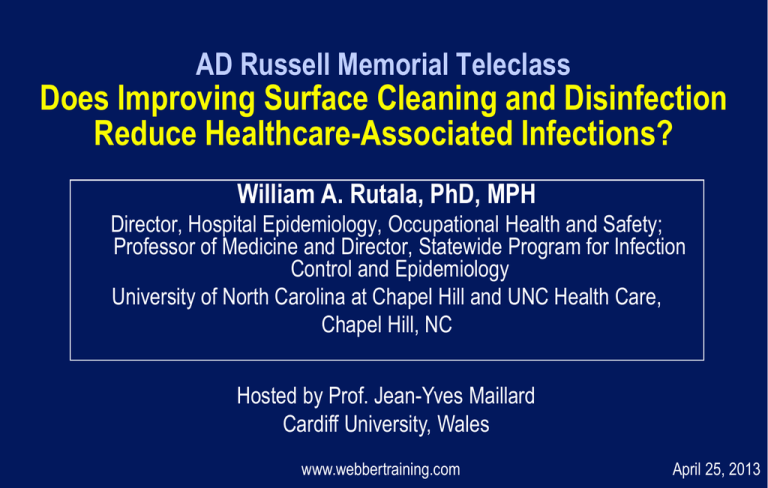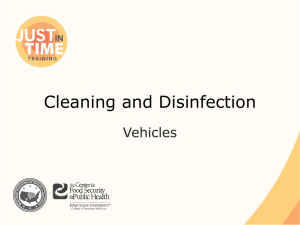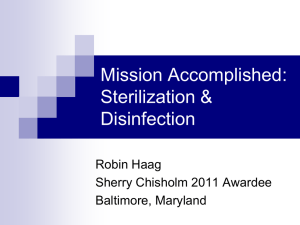Does Improving Surface Cleaning and
advertisement

AD Russell Memorial Teleclass Does Improving Surface Cleaning and Disinfection Reduce Healthcare-Associated Infections? William A. Rutala, PhD, MPH Director, Hospital Epidemiology, Occupational Health and Safety; Professor of Medicine and Director, Statewide Program for Infection Control and Epidemiology University of North Carolina at Chapel Hill and UNC Health Care, Chapel Hill, NC Hosted by Prof. Jean-Yves Maillard Cardiff University, Wales www.webbertraining.com April 25, 2013 The A. Denver Russell Memorial Teleclass Lecture (2013) Professor Allan Denver Russell (1936-2004) Does Improving Surface Cleaning and Disinfection Reduce Healthcare-Associated Infections? Objectives • • • • Role of the environment in disease transmission Adequacy of room cleaning and monitoring thoroughness of room cleaning Methods for room decontamination Does improved surface disinfection reduce HAIs Does Improving Surface Cleaning and Disinfection Reduce Healthcare-Associated Infections? Objectives • • • • Role of the environment in disease transmission Adequacy of room cleaning and monitoring thoroughness of room cleaning Methods for room decontamination Does improved surface disinfection reduce HAIs HEALTHCARE-ASSOCIATED INFECTIONS IN THE US: IMPACT • • 1.7 million healthcare-associated infections (HAIs) per year 98,987 deaths due to HAI • Pneumonia 35,967 Bloodstream 30,665 Urinary tract 13,088 Surgical site infection 8,205 Other 11,062 6th leading cause of death (after heart disease, cancer, stroke, chronic lower respiratory diseases, and accidents)1 1 National Center for Health Statistics, 2004 Multiple Factors Influence Infection Rates Environmental disinfection Hand hygiene Contact precautions Healthcareassociated infections Identification of infected or colonized patients Antimicrobial stewardship ENVIRONMENTAL CONTAMINATION LEADS TO HAIs • • There is increasing evidence to support the contribution of the environment to disease transmission This supports comprehensive disinfecting regimens (goal is not sterilization) to reduce the risk of acquiring a pathogen from the healthcare environment/equipment KEY PATHOGENS WHERE ENVIRONMENTIAL SURFACES PLAY A ROLE IN TRANSMISSION • • • • • • • MRSA VRE Acinetobacter spp. Clostridium difficile Norovirus Rotavirus SARS ENVIRONMENTAL CONTAMINATION LEADS TO HAIs • • • • • • • Frequent environmental contamination Microbial persistence in the environment HCW hand contamination Relationship between level of environmental contamination and hand contamination Transmission directly or on hands of HCPs Housing in a room previously occupied by a patient with the pathogen of interest is a risk factor for disease Improved surface cleaning/disinfection reduces disease incidence TRANSMISSION MECHANISMS INVOLVING THE SURFACE ENVIRONMENT Rutala WA, Weber DJ. In:”SHEA Practical Healthcare Epidemiology” (Lautenbach E, Woeltje KF, Malani PN, eds), 3rd ed, 2010. TRANSMISSION MECHANISMS INVOLVING THE SURFACE ENVIRONMENT Rutala WA, Weber DJ. In:”SHEA Practical Healthcare Epidemiology” (Lautenbach E, Woeltje KF, Malani PN, eds), 3rd ed, 2010. ENVIRONMENTAL CONTAMINATION ENDEMIC AND EPIDEMIC MRSA Dancer SJ et al. Lancet ID 2008;8(2):101-13 ENVIRONMENTAL SURVIVAL OF KEY PATHOGENS ON HOSPITAL SURFACES Adapted from Hota B, et al. Clin Infect Dis 2004;39:1182-9 and Kramer A, et al. BMC Infectious Diseases 2006;6:130 FREQUENCY OF ACQUISITION OF MRSA ON GLOVED HANDS AFTER CONTACT WITH SKIN AND ENVIRONMENTAL SITES No significant difference on contamination rates of gloved hands after contact with skin or environmental surfaces (40% vs 45%; p=0.59) Stiefel U, et al. ICHE 2011;32:185-187 ACQUISITION OF MRSA ON HANDS AFTER CONTACT WITH ENVIRONMENTAL SITES ACQUISITION OF MRSA ON HANDS/GLOVES AFTER CONTACT WITH CONTAMINATED EQUIPMENT TRANSFER OF MRSA FROM PATIENT OR ENVIRONMENT TO IV DEVICE AND TRANSMISSON OF PATHOGEN TRANSMISSION MECHANISMS INVOLVING THE SURFACE ENVIRONMENT Rutala WA, Weber DJ. In:”SHEA Practical Healthcare Epidemiology” (Lautenbach E, Woeltje KF, Malani PN, eds), 3rd ed, 2010. ACQUISITION OF C. difficile ON PATIENT HANDS AFTER CONTACT WITH ENVIRONMENTAL SITES AND THEN INOCULATION OF MOUTH Does Improving Surface Cleaning and Disinfection Reduce Healthcare-Associated Infections? Objectives • • • • Role of the environment in disease transmission Adequacy of room cleaning and monitoring thoroughness of room cleaning Methods for room decontamination Does improved surface disinfection reduce HAIs Thoroughness of Environmental Cleaning Carling PC et al. ECCMID, Milan, Italy, May 2011 >110,000 Objects Mean = 32% RELATIVE RISK OF PATHOGEN ACQUISITION IF PRIOR ROOM OCCUPANT INFECTED * Prior room occupant infected; ^Any room occupant in prior 2 weeks infected EVALUATION OF HOSPITAL ROOM ASSIGNMENT AND ACQUISITION OF CDI Study design: Retrospective cohort analysis, 2005-2006 Setting: Medical ICU at a tertiary care hospital Methods: All patients evaluated for diagnosis of CDI 48 hours after ICU admission and within 30 days after ICU discharge Results (acquisition of CDI) Admission to room previously occupied by CDI = 11.0% Admission to room not previously occupied by CDI = 4.6% (p=0.002) Shaughnessy MK, et al. ICHE 2011;32:201-206 Thoroughness of Environmental Cleaning Carling PC et al. ECCMID, Milan, Italy, May 2011 >110,000 Objects Mean = 32% Mean proportion of surfaces disinfected at is 32% Terminal cleaning methods ineffective (products effective practices deficient [surfaces not wiped]) in eliminating epidemiologically-important pathogens MONITORING THE EFFECTIVENESS OF CLEANING Cooper et al. AJIC 2007;35:338 • • • • Visual assessment-not a reliable indicator of surface cleanliness ATP bioluminescence-measures organic debris (each unit has own reading scale, <250-500 RLU) Microbiological methods-<2.5CFUs/cm2-pass; can be costly and pathogen specific Fluorescent marker-transparent, easily cleaned, environmentally stable marking solution that fluoresces when exposed to an ultraviolet light (applied by Infection Preventionist unbeknown to EVS, after EVS cleaning, markings are reassessed) Target After Marking Target Enhanced SURFACE EVALUATION USING ATP BIOLUMINESCENCE Swab surface luciferace tagging of ATP Hand held luminometer Used in the commercial food preparation industry to evaluate surface cleaning before reuse and as an educational tool for more than 30 years. ENVIRONMENTAL CONTAMINATION LEADS TO HAIs Suboptimal Cleaning • • There is increasing evidence to support the contribution of the environment to disease transmission This supports comprehensive disinfecting regimens (goal is not sterilization) to reduce the risk of acquiring a pathogen from the healthcare environment Does Improving Surface Cleaning and Disinfection Reduce Healthcare-Associated Infections? Objectives • • • • Role of the environment in disease transmission Adequacy of room cleaning and monitoring thoroughness of room cleaning Methods for room decontamination Does improved surface disinfection reduce HAIs DISINFECTION AND STERILIZATION Rutala, Weber, HICPAC. 2008. www.cdc.gov • EH Spaulding believed that how an object will be disinfected depended on the object’s intended use CRITICAL - objects which enter normally sterile tissue or the vascular system or through which blood flows should be sterile SEMICRITICAL - objects that touch mucous membranes or skin that is not intact require a disinfection process (high-level disinfection[HLD]) that kills all microorganisms but high numbers of bacterial spores NONCRITICAL - objects that touch only intact skin require lowlevel disinfection LOW-LEVEL DISINFECTION FOR NONCRITICAL EQUIPMENT AND SURFACES Germicide Exposure time > 1 min Use Concentration Ethyl or isopropyl alcohol 70-90% Chlorine 100ppm (1:500 dilution) Phenolic UD Iodophor UD Quaternary ammonium UD Improved hydrogen peroxide (HP) 0.5%, 1.4% ____________________________________________________ UD=Manufacturer’s recommended use dilution ALL “TOUCHABLE” (HAND CONTACT) SURFACES SHOULD BE WIPED WITH DISINFECTANT “High touch” objects only recently defined (no significant differences in microbial contamination of different surfaces) and “high risk” objects not epidemiologically defined. Effective Surface Decontamination Practice and Product EFFECTIVENESS OF DISINFECTANTS AGAINST MRSA AND VRE Rutala WA et al. Infect Control Hosp Epidemiol 2000;21:33-38. SURFACE DISINFECTION Effectiveness of Different Methods, Rutala et al. 2012 Wipes Cotton, Disposable, Microfiber, Nonwoven Spunlace Wipe should have sufficient wetness to achieve the disinfectant contact time. Discontinue use of a disposable wipe if it no longer leaves the surface visibly wet for > 1m Surface Disinfection • Wipe all “touchable” or “hand contact” surfaces with • sufficient wetness to achieve the disinfectant contact time (> 1 minute). Daily disinfection of surfaces (vs cleaned when soiled) in rooms of patients with CDI and MRSA reduced acquisition of pathogens on hands after contact with surfaces and on hands caring for the patient Daily Disinfection of High-Touch Surfaces Kundrapu et al. ICHE 2012;33:1039 Daily disinfection of high-touch surfaces (vs cleaned when soiled) with sporicidal disinfectant in rooms of patients with CDI and MRSA reduced acquisition of pathogens on hands after contact with surfaces and of hands caring for the patient Does Improving Surface Cleaning and Disinfection Reduce Healthcare-Associated Infections? Objectives • • • • Role of the environment in disease transmission Adequacy of room cleaning and monitoring thoroughness of room cleaning Methods for room decontamination Does improved surface disinfection reduce HAIs Environmental Disinfection Interventions Donskey CJ. AJIC. May 2013. 1. Cleaning product substitutions 2. Improvements in the effectiveness of cleaning and disinfection practices Education Audit and feedback Addition of housekeeping personnel or specialized cleaning staff 3. Automated technologies Disinfectant Product Subsitutions Donskey CJ. AJIC. May 2013 Disinfectant Product Substitutions Donskey CJ. AJIC. May 2013 • • • Six of the 7 interventions were quasi-experimental studies in which rates were compared before and after interventions with no concurrent control group Confounding factors not reported (e.g., hand hygiene or Contact Precaution compliance) Decrease in the incidence in 6 of 7 studies Substitution of Hypochlorite for Non-Sporicidal Cleaning Agents to Control C. difficile Ref Setting Effect on CDI rates 1 Medical Ward Outbreak ended 2 Bone marrow transplant (BMT) unit, Medical Ward, ICU Significant decrease on BMT unit, but not on the other 2 wards 3 2 medical wards (crossover study) Decreased on 1 of 2 wards 4 Medical and surgical ICUs Decreased on both units 5 3 hospitals 48% decrease in prevalence density of CDI 6 2 medical wards 85% decrease in hospital acquired CDI 1). Kaatz G. Am J Epidemiol 1988;127:1289-94; 2). Mayfield JL. Clin Infect Dis 2000;31:995-1000; 3). Wilcox MH. J Hosp Infect 2003;54:109-114; 4). McMullen KM. Infect Control Hosp Epidemiol 2007;28:205-7; 5). Hacek DM. Am J Infect Control 2010;38:350-3; 6). Orenstein R. Infect Control Hosp Epidemiol 2011;32:1137-9 Effect of Environmental Disinfection with 10% Bleach on CDI Rates Rate per 1,000 patientdays (results suggest greater impact when baseline incidence is high) 9 8 7 6 5 4 3 2 1 0 HR=0.37 HR=0.93 HR=1.11 Bone marrow transplant Neurosurgical ICU Pre-intervention Post-intervention General medicine Mayfield JL, et al. Clin Infect Dis. 2000;31:995-1000 CDI Decreased When Bleach Substituted for QUAT (higher study quality-repeated treatment design) Mayfield JL, et al. Clin Infect Dis. 2000;31:995-1000 Incidence Decreased on the Ward with the Higher Baseline CDI Rate (no decrease in environmental contamination during hypochlorite periods-application of chlorine suboptimal?) Wilcox MH. J Hosp Infect 2003;54:109-114 Environmental Disinfection Interventions Donskey CJ. AJIC. May 2013. 1. Cleaning product substitutions 2. Improvements in the effectiveness of cleaning and disinfection practices Education Audit and feedback Addition of housekeeping personnel or specialized cleaning staff 3. Automated technologies Improve Effectiveness of Cleaning/Disinfection Donskey CJ. AJIC. May 2013 Cleaning Interventions Associated with Reduced Acquisition of Pathogens Ref Setting/Organism Intervention 1 Burn ICU/VRE Twice daily cleaning 2 Medical ICU/VRE Improved daily and terminal cleaning 3 10 ICUs VRE &MRSA Feedback using fluorescent markers, bucket cleaning 4 Neuro ICU Acinetobacter Hypochlorite and education of cleaning staff 5 Surgical ward/MRSA Increased cleaning hours/wk including shared equipment and dust 6 2 surgical wards MRSA 1 additional cleaner; 6 month cross-over design 1). Falk PS. Infect Control Hosp Epidemiol 2000;21:575-82; 2). Hayden MK. Clin Infect Dis 2000;42:1552-60; 3). Datta R. Arch Intern Med 2011;171:491-4; 4). Denton M. J Hosp Infect 2004;56:106-1; 5). Rampling A. J Hosp Infect 2001;49:109-16; 6). Dancer SJ. BMC Medicine 2009;7:28 Cleaning Interventions Associated with Reduced Acquisition of Pathogens Ref Monitoring of disinfection Effect 1 ↓ environmental contamination Outbreak ended 2 ↓ environ/hand contamination ↓ VRE acquisition 3 ↓ % of rooms contaminated with MRSA or VRE after cleaning (27% versus 45%) ↓ acquisition of MRSA and VRE 4 ↓ environmental contamination Outbreak ended 5 ↓ environmental contamination (11% to 0.7%) ↓ MRSA acquisition 6 ↓ microbial contamination 33% No decrease in environmental MRSA ↓ MRSA infections 27% 1). Falk PS. Infect Control Hosp Epidemiol 2000;21:575-82; 2). Hayden MK. Clin Infect Dis 2000;42:1552-60; 3). Datta R. Arch Intern Med 2011;171:491-4; 4). Denton M. J Hosp Infect 2004;56:106-1; 5). Rampling A. J Hosp Infect 2001;49:109-16; 6). Dancer SJ. BMC Medicine 2009;7:28 Improve Effectiveness of Cleaning/Disinfection Donskey CJ. AJIC. May 2013 • • • Seven of the 9 interventions, pathogen acquisition was reduced or an outbreak resolved. Decrease in environmental contamination in 8 of 9 studies Interventions included: variety of different cleaning strategies (daily disinfection and/or disinfection of portable equipment, education of housekeepers, new protocols or checklists and designation of responsibility for cleaning specific items). Reduction in Acquisition of VRE after Enforcement of Routine Cleaning (Period 1-baseline; 2-educ/thorough cleaning [↑ cleaning rates]; 3-”washout”; 4-HH) Hayden MK, et a. Clin Infect Dis 2006;42:1552-60 Do we have to get to zero contamination after disinfection to reduce infections? Ref Measurement 1 % sites positive for VRE after cleaning 2/3 % rooms with >1 sites positive for MRSA or VRE after cleaning Baseline 10% 45% Intervention Effect 3 - 4% ↓ VRE acquisition (hazard ratio 0.36) 27% ↓ acquisition of MRSA by 49% and VRE by 29% 1. Hayden MK, et a. Clin Infect Dis 2006;42:1552-60; 2. Goodman ER, et al. Infect Control Hosp Epidemiol 2008;29:593-9; 3. Datta R, et al. Arch Intern Med 2011;171:491-4 Environmental Disinfection Interventions Donskey CJ. AJIC. May 2013. 1. Cleaning product substitutions (improved effectiveness) 2. Improvements in the effectiveness of cleaning and disinfection practices Education Audit and feedback Addition of housekeeping personnel or specialized cleaning staff 3. Automated technologies Touch (manual disinfection not thorough) vs No-Touch (mechanical) No Touch (supplements but do not replace surface cleaning/disinfection; avoids the need for “touch” and the problems associated with manual disinfection) NEW “NO TOUCH” APPROACHES TO ROOM DECONTAMINATION Supplement Surface Disinfection Rutala, Weber. Infect Control Hosp Epidemiol. 2011;32:743 ROOM DECONTAMINATION UNITS Rutala, Weber. ICHE. 2011;32:743 UV and HP systems have been demonstrated to be effective against various healthcare-associated pathogens Automated Disinfection Devices Donskey CJ. AJIC. May 2013 Automated Disinfection Devices Donskey CJ. AJIC. May 2013 • • Hydrogen peroxide vapor has been used in outbreak settings and has been associated with reductions in colonization or infection with pathogens. Boyce et al demonstrated that HP vapor for terminal disinfection of CDI rooms was associated with a significant reduction in the incidence of CDI Reduction in CDI on 5 High-Incidence Wards with Hydrogen Peroxide Vapor Disinfection 1 % sites contaminated Before HP vapor After HP vapor 26% 0% 1. Boyce JM et al. Infect Control Hosp Epidemiol 2008;29:723-9 Equipment Associated with Outbreaks (disinfection or replacement of contaminated equipment effective in eliminating outbreaks. Donskey CJ. AJIC May 2013) Ultrasonic nebulizers 1 MRSA Hydrotherapy equipment MRSA 2 Electronic thermometers C. difficile and VRE 3-5 1. Schultsz C, et al. J Hosp Infect 2003;55:269-75; 2. Embil JM, et al. Burns 2001;27:681-8; 3. Brooks SE et al. Infect Control Hosp Epidemiol 1992;13:98-103; 4. Jernigan JA, et al. Infect Control Hosp Epidemiol 1998;494-9; 5. Livornese LL, et al. Ann Intern Med 1992;117:112-116; 6. Cotterill S, et al. J Hosp Infect 1996;32:207-16; 7. Kumari DN, et al. J Hosp Infect 1998;39;127-33; 8. Engelhart S, et al. J Hosp Infect 2002;52:93-98 Does Improving Surface Cleaning and Disinfection Reduce Healthcare-Associated Infections? Summary • • • Multiple publications suggest that environmental disinfection interventions can reduce acquisition of healthcare-associated pathogens Additional high-quality studies are needed Reductions in pathogen acquisition have been achieved despite less than perfect room disinfection Acknowledgment • • Several slides provided by Curtis J. Donskey, MD, Cleveland VA Medical Center and Case Western Reserve School of Medicine, Cleveland, OH. June 2012 Donskey CJ. Does improving surface cleaning and disinfection reduce healthcare-associated infections? Am J Infect Control May 2013. www.disinfectionandsterilization.org THANK YOU! 06 May (Free WHO Teleclass … Europe … Special Lecture for May 5) HAND HYGIENE PROMOTION UNIVERSAL SPREAD: IMPACT AND PARTICIPATION PATIENT Speaker: Prof. Didier Pittet, University of Geneva Hospitals Margaret Murphy, Patients for Patient Safety, WHO 09 May SURVEILLANCE OF HEALTHCARE ASSOCIATED INFECTION IN ACUTE CARE SETTINGS Speaker: Teresa Horan, Rollins School of Public Health, Emory University May 16 WHAT’S NEW IN TECHNOLOGIC INNOVATIONS FOR THE PREVENTION OF INTRAVASCULAR CATHETER ASSOCIATED BLOODSTREAM INFECTION Speaker: Prof Mark Rupp, University of Nebraska Medical Center 30 May PREVENTING CATHETER-ASSOCIATED URINARY TRACT INFECTIONS IN ACUTE CARE SETTINGS






